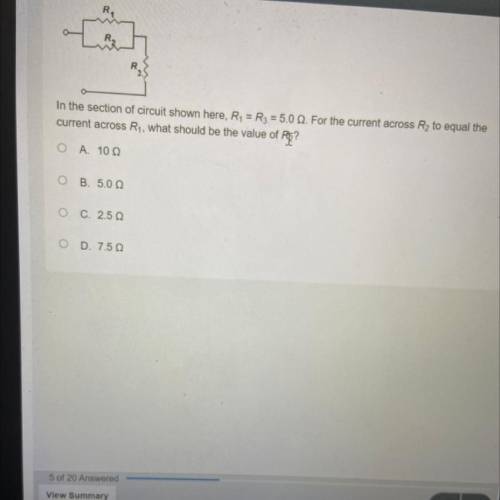
Physics, 13.04.2021 22:20 savannadutton8577
In the section of circuit shown here, R1 = R3 = 5.0 N. For the current across R2 to equal the
current across R1, what should be the value of R2?
THE ANSWER CHOICES ARE ON THE SCREEN JUST PUT A, B, C, OR D when ANSWERING


Answers: 3
Another question on Physics

Physics, 22.06.2019 07:10
Search coils and credit cards. one practical way to measure magnetic field strength uses a small, closely wound coil called a search coil. the coil is initially held with its plane perpendicular to a magnetic field. the coil is then either quickly rotated a quarter-turn about a diameter or quickly pulled out of the field. (a) derive the equation relating the total charge q that flows through a search coil to the magnetic-field magnitude b. the search coil has n turns, each with area a, and the flux through the coil is decreased from its initial maximum value to zero in a time ∆t. the resistance of the coil is r, and the total charge is q = i∆t, where i is the average current induced by the change in flux. (b) in a credit card reader, the magnetic strip on the back of a credit card is rapidly “swiped” past a coil within the reader. explain, using the same ideas that underlie the operation of a search coil, how the reader can decode the information stored in the pattern of magnetization on the strip. (c) is it necessary that the credit card be “swiped” through the reader at exactly the right speed? why or why not?
Answers: 2

Physics, 22.06.2019 09:30
Astone is dropped from a cliff and falls 9.44 meters. what is the speed of the stone when it reaches the ground? a. 13.6 m/sec b. 1.39 m/sec c. 185 m/sec d. 9.80 m/sec
Answers: 3

Physics, 22.06.2019 13:30
Select the three ways that the parallel-plate capacitor differs from a car battery.
Answers: 1

Physics, 22.06.2019 19:40
It may seem strange that the selected velocity does not depend on either the mass or the charge of the particle. (for example, would the velocity of a neutral particle be selected by passage through this device? ) the explanation of this is that the mass and the charge control the resolution of the device--particles with the wrong velocity will be accelerated away from the straight line and will not pass through the exit slit. if the acceleration depends strongly on the velocity, then particles with just slightly wrong velocities will feel a substantial transverse acceleration and will not exit the selector. because the acc
Answers: 1
You know the right answer?
In the section of circuit shown here, R1 = R3 = 5.0 N. For the current across R2 to equal the
curre...
Questions






















